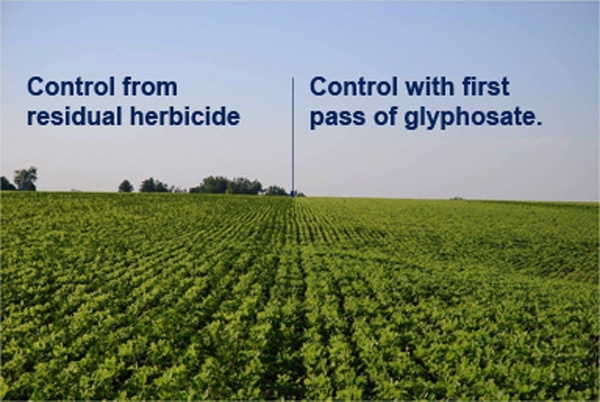May 14, 2012

It’s been another abnormal spring and many farmers have had to adjust some of their management practices. Specifically, the combination of the unusual weather and a need to get control of glyphosate-resistant weeds has increased the need to more closely scrutinize weed-management programs.
Aerial imagery can provide feedback on the degree of weed pressure in a field. Early season weed growth can be detected using an infrared band. Shown here is an image of a southwest Iowa field showing weed pressure differences across the field.

A strip trial in this field compared an all glyphosate weed mamagement system to one with a pre-emergence application of a residual herbicide and a later application of glyphosate. On the left side of the field there was an obvious difference in grass pressure that was detectable in the all glyphosate strips (looks more pink in strips). You can also see the pressure stops just short of the halfway across the field point. This was an old field boundary that is now farmed through. The right side of the field however shows some strips of weed pressure as well (more prevalent in the bottom half). Ground-truthing confirmed the uncontrolled weeds (mostly in the strips treated with glyphosate) were primarily lambsquarter.
So with the unusual weather and changing dymamics of weed management, you may want to collect some images to see what is happening on your farm. For more information and examples regarding this, check out a pdf presentation on herbicide trials.
So, why is this information useful? First, it’s a reminder that prior management can impact weed problems. These two fields had been combined into one for at least two years when this image was taken in 2008, but weed species, and thus, needed control measures, were different on the left than on the right sides.
Second, the strip trial itself (photo above) shows that a pre-emergence herbicide can hold down early season weed growth and make for cleaner fields in combination with a properly timed post-emergence glyphosate application. With the pre-emergence residual herbicide holding back weed growth, the window in which to make those glyphosate applications can be wider, giving you control until you can get into the field.
We should also note for the record, that even though weeds seem to have been controlled better in the strips where the residual herbicide was used, in the end, yields from the two-pass glyphosate strips were nearly identical to those from the pre-emergence + glyphosate strips.
You May Also Like




